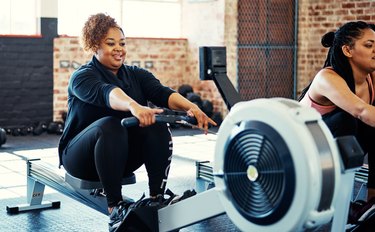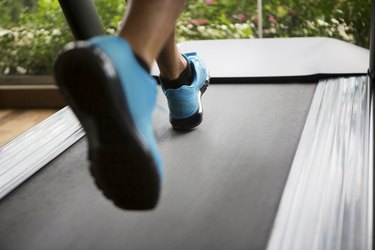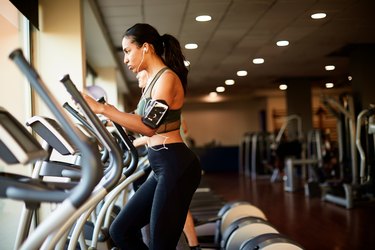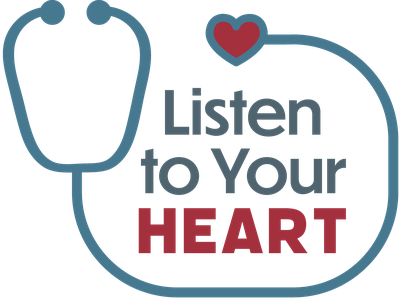
The heart wants what it wants: To beat quicker than usual for 75 to 150 minutes each week.
Crushes and horror movies might get it pumping faster for a little while, but the heart's long-term favorite will always be exercise. Because regular cardio workouts don't just keep the heart strong (which in turn keeps the rest of the body strong) — they're also linked to better blood pressure, reduced stress and inflammation, lower risk of heart disease and stroke, successful weight loss and weight management and much, much more, according to Johns Hopkins Medicine.
In a perfect world, you'd get at least 150 minutes of moderate-intensity cardio (also called aerobic activity) or 75 minutes of vigorous exercise a week (or a combination of both), according to the Physical Activity Guidelines for Americans.
That may sound like a lot, but you can reach those benchmarks with about 10 to 20 minutes of activity a day. And if 10 minutes doesn't fit into your schedule at the moment, that's OK, too: Any movement is better than none, especially if you follow our experts' advice for making the most of your limited time.
There's a little something for everyone in the wild world of cardio — find what best fits your needs below.
Cardio Newbies, Start Here

Your very first cardio workout doesn't have to look like something out of the Rocky movies: Walking for 20 minutes on a treadmill or around your neighborhood is totally acceptable — in fact, it's smart.
"If you start on the easy-to-moderate end and build up over time, you're much more likely to avoid injury or overtraining, which can diminish results," says Tim Hampton, CSCS, certified personal trainer with elevate Health & Performance.
One of the most exciting (though potentially overwhelming) parts of being a beginner is discovering all the different kinds of cardio out there and finding the one that best suits your needs. Got achy joints? Check out the elliptical. Not a fan of running? Try the stationary bike. Looking for a workout that's new every session? Go for body-weight high-intensity interval training (HIIT).
When you're ready to take things to the next level, change one aspect at a time. If you already ride your bike to work, try the full-body, low-impact workout an elliptical provides. Or if you're used to steady-state cardio (maintaining the same level of effort the whole time you're exercising), add a few 30-second bursts of speed or increased resistance to up the intensity. There's always a way to keep your cardio fun and engaging — for your muscles and your mind.
The gym is full of possibilities when you're new to cardio.
How to Lose Weight With Cardio Workouts

Aerobic exercise can help you lower the number on the scale, but it requires a bit more than 30 mindless minutes on a recumbent bike while watching a football game.
To start, you might need to invest a little more time in cardio. Exercising for more than 200 minutes a week (think: five bouts of 40 to 45 minutes each) results in more weight loss than the minimum physical activity recommendations, according to January 2014 research published in Progress in Cardiovascular Diseases.
The kind of cardio you choose matters, too. Alternating between sprints and recovery with HIIT helps you burn more calories in a shorter amount of time. It's especially useful for people with packed schedules who struggle to fit in longer or more frequent workouts.
You'll also need to avoid rewarding every session on the rowing machine with a double-serving of pasta if weight loss is your goal. Support your efforts in the kitchen by making sure you're burning more calories than you're taking in; getting mostly whole-food proteins, healthy fats and complex carbs; and cutting back on highly processed foods.
Some cardio workouts are better than others when it comes to helping you lose weight.
All the Amazing Health Benefits of Cardio

Cardio doesn't only help you lose weight. There are other, more immediate benefits. When you're feeling sluggish and run-down, a heart-pounding sweat session can reinvigorate you by sharpening your focus and short-term memory. It may also help you sleep better, boost your mood and reduce your risk of depression and anxiety.
Another big reason to get plenty of cardio should be obvious from the name: Cardiovascular exercise is good for your heart. Regular cardio workouts can help lower blood pressure, raise HDL (aka "good") cholesterol and manage blood sugar and insulin levels, according to the National Heart, Lung and Blood Institute.
Making time for cardio can help you live a longer, happier, healthier life.
Interval Workouts Keep Things Interesting

Interval cardio workouts, which alternate bouts of activity with short periods of rest, aren't just good for weight loss or tight schedules; they can also kickstart lagging energy levels and help keep exercise interesting and engaging. There are lots of different cardio HIIT options, but one thing will always remain the same: You'll switch between high-intensity work and lower-intensity movements (or even rest).
"The working set can be anywhere between 40 seconds to 4 minutes, and the rest is minimal between sets to quickly catch your breath before starting again," Meghan Hayden, certified personal trainer at Performix House in New York City, tells LIVESTRONG.com. "The goal is to push as hard as possible during the 'work' intervals to get a max number of calories burned in a short amount of time."
Incorporating interval cardio into your next workout can help keep things fresh.
Treadmill Workouts for Indoor Runners

Even a mere 50 minutes of running a week is linked to a lower risk of cancer, heart disease and other life-threatening health conditions, according to a November 2019 study published in the British Journal of Sports Medicine. If you can't get to the great outdoors to log those minutes, the treadmill is a solid alternative.
The key to getting the most out of your treadmill time is variety and a little bit of fun. You have lots of creative options: Craft your own HIIT routine, take a treadmill workout class or watch your favorite TV show (as long as you don't let it lull you into auto-pilot).
Beat "dreadmill" boredom and find your new favorite treadmill workout.
Low-Impact Elliptical Workouts

If you have back pain, bad knees or another reason to avoid high-impact exercise, the elliptical can help you meet your weekly activity recommendations without aggravating problem areas.
"The elliptical trainer does not cause excessive pressure to the joints, hence decreasing the risk of impact injuries," says Michaelangelo Villalba, elite trainer at Crunch Fitness Union Square. It earns its low-impact status, he explains, because "it keeps your heels in contact with the pedals, reducing muscle and tendon stress."
The elliptical is also a smart cross-training machine for runners who want to stay healthy. You're still getting your heart pounding and muscles moving but in a different way, so you avoid overuse injuries and limit the jarring impact of pounding the pavement.
Lose weight, build endurance or strengthen your upper or lower body with a customized elliptical workout.
Lower-Body Stationary Bike Workouts

Stationary bike workouts, like many other types of aerobic exercise, are fully customizable. You can tailor them to your fitness level and goals by ramping up your speed or revolutions per minute (RPM) or cranking the resistance to simulate cycling uphill.
"The intensity of your workout is defined by level of resistance and your leg speed," says Rhodie Lorenz, cycling instructor and founder of JoyRide Studio in Westport, Connecticut. "Because the resistance can always be turned up, you have the opportunity to continuously push yourself to the next level."
Plus, you don't have to sign up for a class at a studio like SoulCycle or Flywheel; you can design your own indoor cycling workout, complete with warm-up, sprint intervals and a motivating playlist to replicate the experience anywhere you have access to a bike.
Take your cycling indoors with stationary bike workouts.
